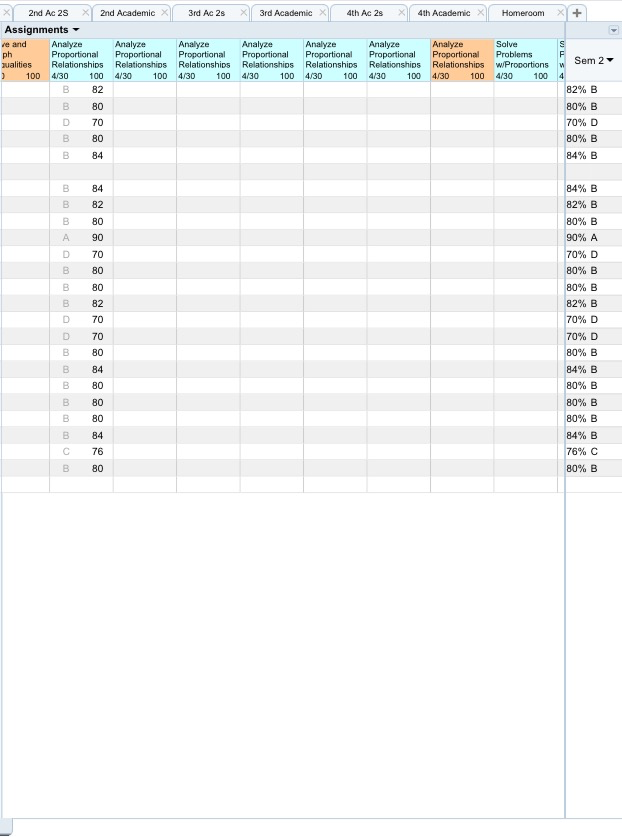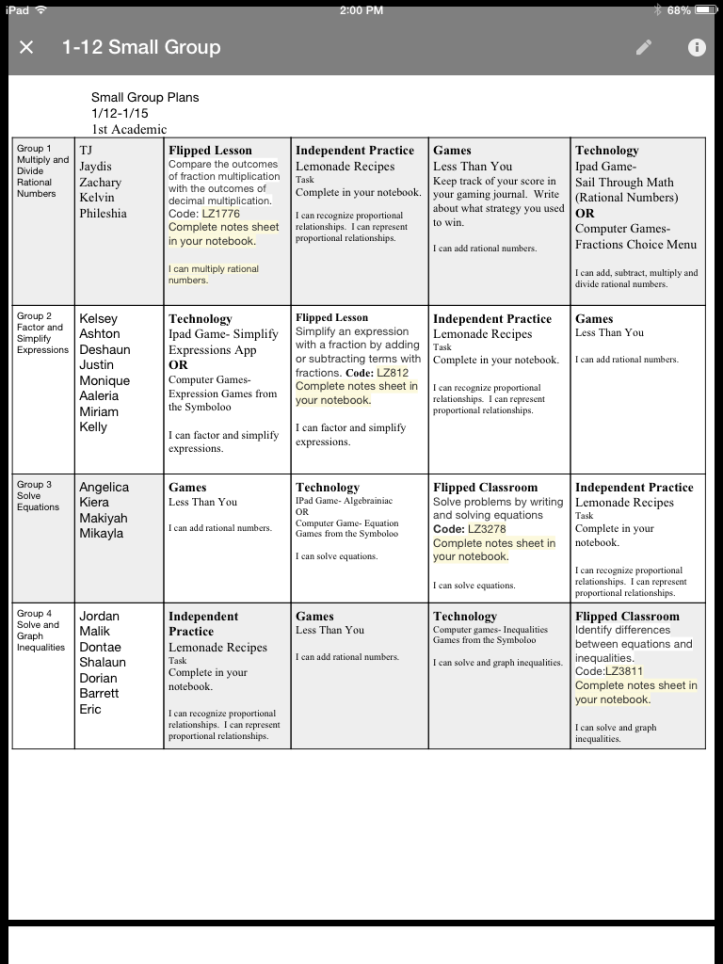I’ve gotten into the habit of layering on change for my students. This is mainly due to receiving feedback and adjusting classroom structure to meet the needs of students. This characteristic will not change in 2015. Here are the changes I’m layering on so far.
1. Using our overview documents, the “power” learning targets were identified. I went ahead and entered all of them into my gradebook. By doing this, I can group together the formative assignments (my checkpoints along the way) with the summative assessment score for each target. As students demonstrate their understanding of the target, I’ll enter the score. Students and parents should be able to see the progression of understanding reflected in the gradebook as they work towards mastery. My hope is assignments will not seem so individualized.
 Here’s a snapshot of my gradebook.
Here’s a snapshot of my gradebook.
2. I’m introducing a new station during small group rotation. Now we will have a station solely dedicated to flipped learning. It will still be a four station rotation, but the teacher has been removed from the rotation. This idea stems from a vertical team meeting I’ve recently attended, as will as a conversation with a good friend of mine.
Here’s the new setup:
3. Implement Nzmaths Numeracy Project. The plan of attack for this component will build one class at a time. With my 2nd academic class, I’m going to assess my lowest students using the GLoSS assessment. Once I determine their weakest domain and strategy stage level I will pull lessons from the book associated with their weakest domain. These lessons will be implemented in a small group setting. My lowest students will be pulled while we are doing small group rotation. Because I’m no longer a set station, I’m free to pull students from various groups for remediation/acceleration purposes.
For my 4th academic, I’m going to make the lessons from the Numeracy Project my main resource. Normally I use the GA Math Frameworks as my number 1 resource. And I will continue to do so for my 1st through 3rd academic classes. However, my 4th academic class is very unique and my instructional approach must be unique as well. My goal is to implement these lessons with built in scaffolds to build confidence, problem solving skills, number knowledge as well as strategy use, all things they are currently lacking.
4. So extrinsic motivation is in order for my 4th academic class. Therefore I’m instituting a “Superb” board and a no-hands community. I downloaded iLEAP Pick a Student app and entered each student’s name. This will be used to select students to share their thinking during math discussions. Everyone must ensure they are following the discussion in order to get a thoughtful response. When a thoughtful response is given, that student will be able to record their name on the Superb board. Once the Superb board is filled with names of students who gave reasonable and logical explanations, I will select 3 squares (like selecting bingo square). Those who have their name in one of the winning squares will be able to select a reward.
I’m open for feedback and suggestions.

Hi Jenise,
SBMS is going to start Numeracy Project in at least their Title I math class. They are working on the Gloss assessment now. I am interested to see how the middle school students score and what activities you pull for them. You will have to keep us updated. Are you using the new version?
Which school is SBMS? Yes, I plan on using the new version of the GlosS. I used it earlier this year when I modeled it for the Title teacher. Unfortunately, he has decision to continue on his skill and drill path. I like the flow and language of the new version. It is much easier to flow as far as the decisions go.
I came across your blog post when I searched for ‘small group instruction in middle school’. Wow! I love how you planned the groupings, the video, and links. Everything makes it so doable for me and my students.
Wonderful! I’m glad you found my blog helpful. Please let me know if there’s anything I can do to help you.
I am now following you on twitter. I might need to ask about management, such as students who are off task. I would love to collaborate and build up my math program. I do teach 6th grade math intervention.
That would be wonderful!